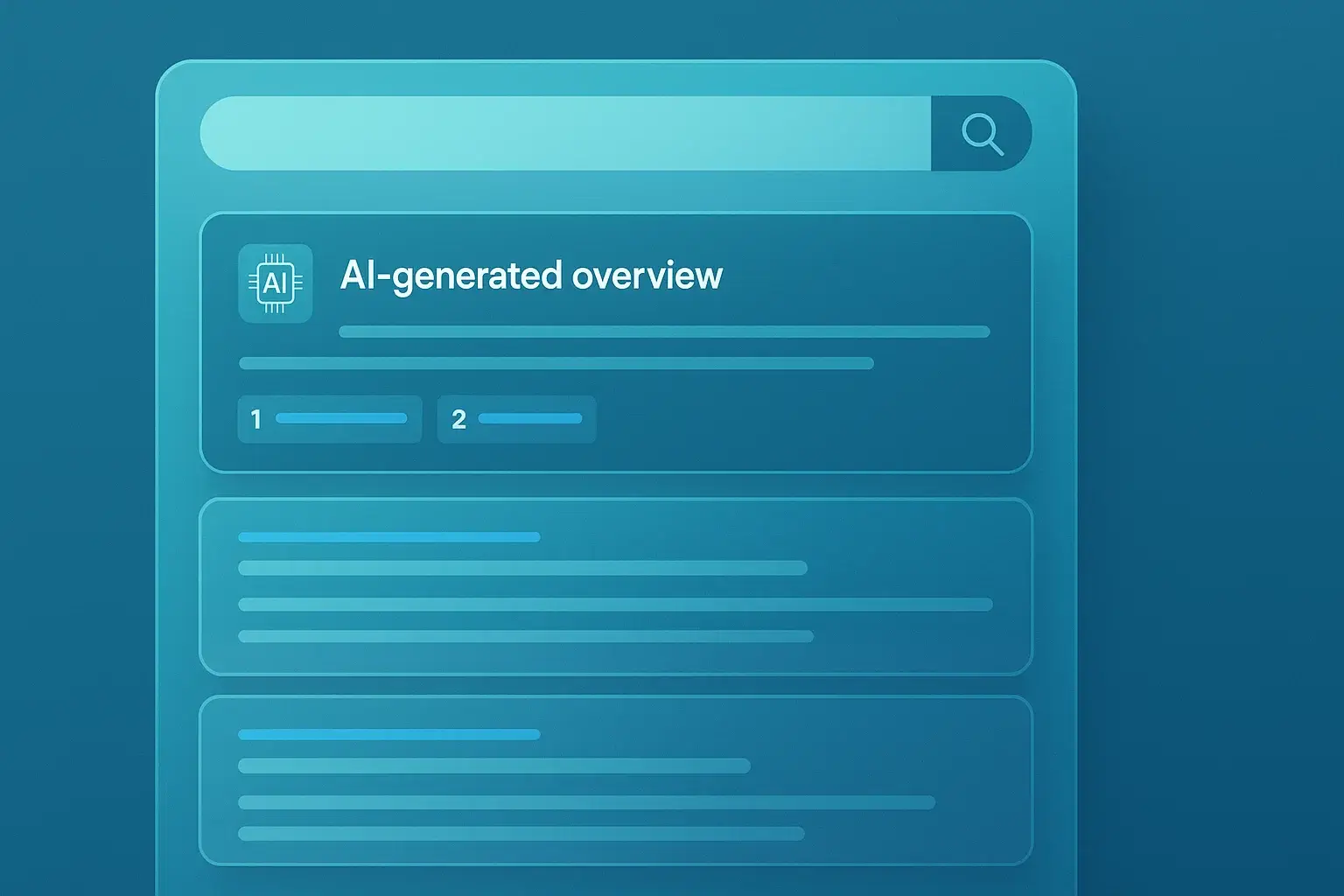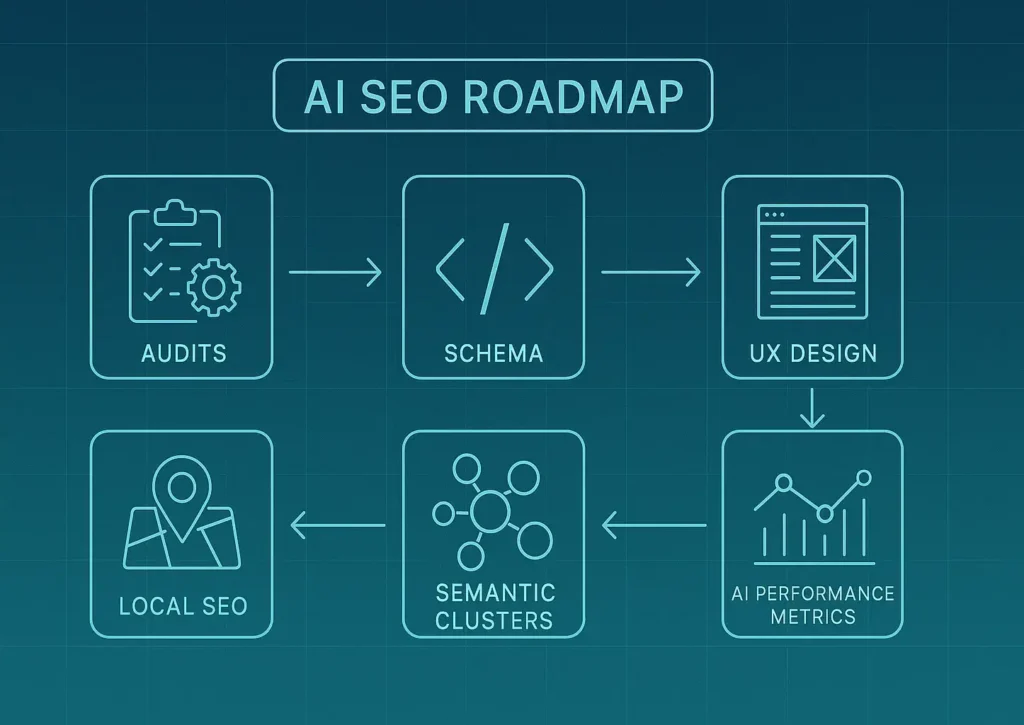AI-powered search results SEO is transforming how websites gain visibility in 2025. With search engines rapidly shifting from keyword-based ranking to AI-driven, multimodal, and conversational discovery, businesses must redesign how content is structured, presented, and optimized. AI systems—not just humans—are now consuming your website, interpreting context, extracting meaning, and generating summaries that influence user decisions long before they land on your page.
The global search landscape is undergoing its fastest evolution in a decade. Recent Google SEO updates for 2025 have accelerated this shift. AI Overviews, ChatGPT Search, Perplexity, and Gemini are rewriting the rules of SEO—prioritizing semantic understanding, contextual depth, entity relationships, and intent-aligned design. This shift means that SEO is no longer just about ranking; it’s about being selected, cited, and surfaced within AI-generated results where competition is tighter and expectations are higher.
In this blog, we break down the top five AI design trends shaping the future of search in 2025, and explain how you can adapt your website’s structure, UX, and content strategy to these emerging standards. You’ll learn exactly how to optimize for AI search, improve your AI content ranking potential, and build an AI SEO strategy that aligns with global search behavior.
Before diving in, let’s understand why AI is reshaping search and what this means for every brand competing for visibility.
Why AI Is Reshaping Search Behavior in 2025
AI is redefining how people discover information, compare solutions, and make decisions online. Traditional search engines relied heavily on keywords, backlinks, and on-page signals—but in 2025, the landscape is driven by semantic understanding, contextual reasoning, multimodal inputs, and answer-first delivery. Users are no longer typing simple queries; they are speaking, uploading images, scanning documents, and asking complex natural-language questions. Search is becoming more conversational, personalized, and predictive.
AI models now parse full content structures—not just headings or keywords—to understand meaning. They analyze entities, relationships, context, and intent before generating an answer. As a result, websites must be designed for machine readability as much as for human readability. Brands that fail to optimize for AI search risk becoming invisible in AI-generated summaries, zero-click answers, and agent-driven recommendations.
AI systems like ChatGPT Search, Google Gemini, Perplexity, and Claude AI evaluate content based on clarity, structure, authority, semantic richness, and UX cleanliness. This shift means that website layout, visual hierarchy, information depth, and structured data can directly influence ranking and AI citation.
To understand what’s driving this change, let’s explore three forces shaping global search behavior in 2025.

The Rise of Answer Engines & AI-Powered SERPs
AI-based search interfaces—known as answer engines—directly respond to user queries with synthesized summaries instead of listing traditional search links. Google’s AI Overviews, Perplexity Answers, and ChatGPT Search extract insights from multiple websites and present them instantly.
This shift reduces conventional CTR but increases the importance of being cited within the AI answer block. Websites designed with structured sections, concise answers, and strong semantic relevance have a far higher chance of being included.
How AI Search Algorithms Understand Content
AI search ranking is no longer about matching keywords—it’s about understanding the meaning behind them.
AI systems evaluate:
- Entities (people, products, industries, concepts)
- Topic relationships & depth
- Content clarity & factual consistency
- UX structure & layout
- Schema markup & machine cues
- Contextual signals across pages
This deeper evaluation impacts AI search algorithm SEO, requiring brands to build semantically rich, well-connected content ecosystems.
Why Traditional Keyword-Only SEO No Longer Works
Keyword stuffing or thin keyword-focused pages no longer perform. AI prefers:
- Structured content blocks
- Fully explained topics
- Clear definitions & examples
- Consistent internal linking
- Logical flow and hierarchy
This is why AI search optimization techniques focus on meaning, context, and design—not just keywords.
As these forces reshape search, brands must adapt their content design to match this intelligence-driven ecosystem. This leads to the five critical AI design trends discussed next.
Top 5 AI Design Trends Dominating 2025
Before exploring the first trend, it’s important to understand that all five trends share a single purpose: helping websites become machine-readable, semantically rich, and UX-optimized for AI-generated search experiences. Each trend directly impacts how AI-powered systems—Gemini, ChatGPT Search, Perplexity, Claude, and other answer engines—interpret, summarise, and cite your content.
Now, let’s begin with Trend 1.
Trend 1 — Conversational & Multimodal Search Experiences

What This Trend Means
Search in 2025 is no longer limited to typed queries. Users interact through:
- Voice commands
- Chat-based conversational queries
- Photo uploads and visual prompts
- Screen recordings
- Mixed inputs like voice + image + text
This new generation of multimodal search allows AI models to interpret multiple signals simultaneously. A user might upload an image of a product, ask a follow-up voice question, and request alternatives—within the same search thread.
This shift demands content and design structures that are flexible, clean, accessible, and easy for AI systems to parse across formats.
Why It Matters for SEO
As search becomes conversational and visual, AI models extract meaning across formats—not just text. That means your website must:
- Present clear conversational headings
- Maintain clean formatting for AI extraction
- Support multimedia with transcripts and alt text
- Follow a logical, scannable hierarchy
- Use definitions, examples, and contextual cues
When sites follow these structures, they’re more likely to be cited in multimodal AI answers, voice-based responses, and visual search summaries. This directly improves semantic search SEO AI, AI content ranking, and overall AI visibility.
How to Optimize (Practical Steps)
- Use conversational subheadings that answer search questions naturally.
Example: “How does AI interpret multimodal content?” - Integrate alt text, transcripts, and captions for all images, videos, and audio files.
- Adopt a dialogue-first content style with simplified language and direct answers.
- Use structured content elements like bullet points, quotes, key takeaways, and FAQs to help AI systems extract information.
- Add robust schema markup to help Google and AI models identify content types, media, and entities.
- Ensure mobile-first and voice-first UX, especially for users relying on voice search and AI assistants.
This trend sets the foundation for AI-first SEO. The cleaner and more structured your website is, the more AI-friendly it becomes—leading to higher visibility in AI-powered SERPs.
Trend 2 — AI Overviews & Answer-First Design
What This Trend Means
One of the biggest changes in 2025 is the rise of AI Overviews—automated summaries generated by search engines and answer engines. These summaries appear before traditional blue links and provide a quick, structured response to user queries. Platforms like Google AI Overviews, ChatGPT Search, Perplexity Answers, and Gemini synthesise content from multiple sources and offer a direct, conversational answer.
Unlike traditional search snippets, AI Overviews pull from:
- High-authority content
- Structured content blocks
- Entity-rich explanations
- Clearly formatted sections
- Verified and contextually relevant sources
This creates an “answer-first” search environment, where the best-designed content—not the highest-ranked URL—gets highlighted.

Why It Matters for SEO
This trend has completely reshaped SEO for AI-powered search.
AI systems extract information based on clarity, structure, semantic richness, and factual strength, not just keywords or backlinks. If your content isn’t designed for answer extraction, you will not appear in AI-generated summaries—regardless of your Google ranking.
Optimizing for AI Overviews can help your brand:
- Earn citations within AI summaries
- Increase zero-click visibility
- Strengthen authority signals
- Drive high-intent traffic from answer engines
- Improve your AI content ranking across platforms
Answer-first content has now become a competitive advantage.
How to Optimize (Practical Steps)
- Write short, precise answer blocks (40–60 words).
– Ideal for AI extraction. - Use structured paragraphs with definition-style openings.
– “AI Overviews are…”
– “AI-powered search results SEO refers to…” - Add supportive lists and bullet points that follow a clear content structure.
– AI models prefer clarity and scanability. - Break long explanations into subheadings.
– Helps AI identify key sections. - Include data, examples, and authoritative claims.
– AI favors verified, credibility-rich content. - Ensure schema markup is implemented site-wide.
– FAQ, Article, Speakable, HowTo, etc.
This is the most important trend for brands wanting visibility inside AI answers—not just traditional SERPs.
Trend 3 — Entity-First, Semantic-Rich Website Structures
What This Trend Means
As AI search systems become more advanced, they rely less on keywords and more on entities—the core concepts that define a topic. In 2025, search engines and AI models understand content by mapping relationships between:
- People
- Organizations
- Places
- Services
- Products
- Medical or technical terms
- Industry-specific concepts
These interconnected pieces form a semantic graph, helping AI interpret meaning with far greater accuracy. This means your website must demonstrate topic depth, semantic clarity, and entity precision across all pages.
For example, instead of merely saying “SEO strategy,” AI expects supporting concepts like “semantic search,” “AI ranking factors,” “entity markup,” and “search intent models.” A website that demonstrates these interconnected ideas is viewed as high authority, increasing its presence in AI responses.
Why It Matters for SEO
Traditional SEO focused on “What keyword are we ranking for?”
AI-first SEO asks: “Does this page demonstrate complete topical and entity understanding?”
Semantic and entity-first structures help you:
- Build topical authority, which AI rewards
- Improve AI content ranking
- Increase chances of appearing in AI summaries
- Strengthen semantic search SEO AI signals
- Make your content easier for AI to contextualize
AI-powered search prioritizes websites that are meaningfully connected, not just keyword-aligned. This is why brands must invest in entity-led content ecosystems, topic clusters, and structured internal linking.

How to Optimize (Practical Steps)
- Use topic clusters instead of standalone blogs.
Create interconnected pages around one central pillar topic. - Add entity-based keywords naturally.
Example:
Instead of “SEO tips,” use “AI SEO strategy,” “semantic indexing,” “content entities,” etc. - Integrate structured data consistently.
- Article
- FAQ
- Product
- Organization
- HowTo
These help AI understand your entities.
- Strengthen internal linking between related topics.
AI uses internal links to map relationships. - Provide definitions, examples, and context.
AI rewards educational depth. - Use consistent terminology across pages.
This helps AI models identify your domain expertise.
Semantic-rich structures are now essential for AI search optimization techniques, enabling websites to rank in AI-generated responses with greater consistency.
Trend 4 — Hyper-Personalized & Localized AI Search
What This Trend Means
AI search engines in 2025 are increasingly personalized. They deliver results based not only on keywords or authority but also on who the user is, where they are, what they prefer, and what they’ve searched before. This shift is powered by AI’s ability to interpret:
- Location signals
- Device type
- Search history
- Behavioral patterns
- Intent clusters
- Demographics & context
This means that two people searching for the same query—“best digital marketing agency,” for example—may receive completely different AI-powered results depending on their location, previous interactions, and personal context.
The era of generic SERPs is over. AI now tailors search results at an individual level, making personalization and local intent optimization absolutely essential.
Why It Matters for SEO
AI search combines global intelligence with hyper-local relevance. For businesses, this means:
- Localized content becomes essential for visibility
- Personalized responses influence conversions
- AI agents prefer businesses with clear local signals
- AI cross-checks multiple attributes (proximity, credibility, reviews)
This trend directly impacts AI local SEO, where AI blends structured metadata, user behavior, and geo-signals to produce highly relevant results.
If your website does not provide structured local data or personalized pathways, AI systems may skip your content entirely in favor of competitors that offer more contextual clarity.
Businesses in industries like healthcare, hospitality, finance, retail, and services must prioritize local optimization to compete in AI-powered discovery ecosystems.
How to Optimize (Practical Steps)
- Add Local Business Schema consistently.
AI systems use schema to understand your NAP (name, address, phone), service areas, and ratings. - Create localized landing pages for each city, region, or audience segment you target.
- Use geo-specific keywords naturally within content.
Example: “AI SEO services for London businesses.” - Optimize your Google Business Profile with updated services, reviews, images, and FAQs.
- Include customer reviews and testimonials—AI heavily factors credibility and sentiment.
- Ensure mobile-first design, as local searches primarily occur on mobile devices.
- Add personalized UX pathways on your website (e.g., “Choose your location,” “Select your industry,” or dynamic recommendations).
These strategies help brands build trust signals that AI models rely on for hyper-personalized ranking decisions.

Trend 5 — Integrated AI–UX–SEO Ecosystem
What This Trend Means
In 2025, website success is no longer determined by SEO alone. AI-powered search engines evaluate websites holistically, blending technical performance, UX clarity, semantic richness, visual structure, and content quality into a single ecosystem of ranking signals.
This new standard is called the AI–UX–SEO ecosystem—a unified model where design, development, and search optimization merge into one continuous, interconnected workflow. AI systems now measure not only what you say but also how efficiently your content is designed, structured, and delivered.
Elements AI evaluates together include:
- Page speed and Core Web Vitals
- Accessibility & readability
- Semantic markup and schema
- Visual hierarchy
- Heading structure
- Mobile-first design
- Media optimization
- User interaction patterns
If any of these components are weak, AI systems may deprioritize your content—even if your information is accurate.
In this integrated environment, clean UX and strong technical foundations are as important as keyword relevance.
Why It Matters for SEO
This trend directly impacts AI search overview SEO and AI SEO best practices. AI-generated answers pull from sites that demonstrate:
- Fast-loading, mobile-friendly layouts
- Clearly structured content
- Minimal distractions and clean UI
- High accessibility (ARIA labels, alt text, contrast)
- Strong internal linking
- Rich entity and schema markup
Websites that combine UX + SEO + AI-readiness create a machine-friendly environment, helping AI systems interpret their content quickly and accurately.
This is critical because modern AI agents simulate user behavior—scroll patterns, time on page, and content engagement—to determine content reliability.
How to Optimize (Practical Steps)
- Improve Core Web Vitals.
Aim for fast loading, low INP, strong LCP, and minimal CLS. - Use a clean, scannable visual hierarchy.
Short paragraphs, clear spacing, large headings, and consistent typography. - Adopt accessibility standards.
Alt text, ARIA labels, semantic HTML, and readable color contrast. - Embed schema throughout your site.
- Article
- FAQ
- Speakable
- Organization
- Breadcrumb
These help AI interpret structure.
- Create a mobile-optimized layout.
Most AI-driven searches occur on mobile devices. - Ensure images and videos are compressed and marked up.
AI uses media metadata to understand your page content. - Integrate UX signals into your SEO strategy.
AI ranks content based on user behavior patterns simulated in real time.
By aligning design, technical structure, and content under one AI-first framework, businesses gain maximum visibility across all AI-powered search environments.
Real-World Use Cases & Global Perspectives
AI-powered search is no longer theoretical — businesses across industries are already using these design trends to improve visibility, increase conversions, and appear more consistently inside AI-generated answers. Whether you’re a global enterprise or a local service provider, optimizing for AI-driven discovery delivers measurable impact.
Below are real-world use cases that show how organizations worldwide are adapting to these AI-first design standards. You can also explore our Latest SEO and AI articles for more real-world examples.
Global Brands Using AI Design Trends for Authority & Reach
Large enterprises with multi-country audiences have quickly adopted semantic-rich, entity-led content ecosystems. They invest heavily in:
- Clear content hierarchies
- UX-first design structures
- Multimodal search optimization
- Global-local content variations
- Strong semantic clusters
This allows them to rank consistently in ChatGPT Search, Google AI Overviews, and Perplexity Answers. Their content appears in AI-generated summaries because it is:
- Context-rich
- Entity-complete
- Structured clearly
- Supported with schema
- Designed for multimodal extraction
Enterprises also use FAQ sections, comparison tables, and structured insights, making their pages ideal for AI to cite.
Local Businesses Leveraging AI Local SEO to Increase Visibility
Small and medium businesses benefit immensely from hyper-personalized AI search. A local clinic, law firm, gym, or restaurant can outperform national competitors by optimizing:
- Local service pages
- Google Business Profile
- Local FAQs
- Review signals
- Location-based schema
Because AI prioritizes relevance over size, a well-optimized local business can appear above larger brands in personalized search scenarios.
For example:
A user searching “best dermatologist near me” will receive localized AI answers enriched by proximity, service relevance, ratings, and schema — not traditional rankings.
SaaS & Tech Companies Using Semantic Design for AI Citations
AI-heavy industries like SaaS, cybersecurity, and finance compete for high-intent audiences. They focus on:
- Semantic keyword clustering
- Entity mapping
- Technical glossaries
- Deep-dive guides
- Structured product comparisons
These formats are consistent with AI search optimization techniques, making their content more likely to appear in AI-powered recommendations and product discovery results across multiple platforms.
Companies that publish structured, entity-rich documentation see higher AI content ranking because AI prefers clarity, accuracy, and depth over superficial keyword targeting.
AI-Powered Search Results SEO Implementation Blueprint
Adopting AI-first SEO isn’t just about updating content — it involves restructuring the way your website is designed, built, and maintained. The following blueprint outlines a practical, step-by-step path that any global or local business can use to become fully aligned with AI-powered search results SEO standards.
This implementation framework connects semantic depth, UX clarity, technical optimization, and structured design into one cohesive system that AI-powered search engines can easily understand, trust, and surface.

Step-by-Step Execution Plan for 2025
1. Conduct an AI-SEO Technical Audit
Evaluate your:
- Core Web Vitals
- Structured data implementation
- Accessibility
- Page hierarchy
- Schema coverage
- Semantic HTML usage
Identify technical barriers that prevent AI systems from reading or interpreting your content properly.
2. Build Semantic & Entity-Rich Topic Clusters
Create pillar pages supported by subtopics.
Ensure each page:
- Offers deep coverage
- Interlinks with related concepts
- Uses consistent terminology
- Matches search intent
- Includes definitions, FAQs, examples
This improves AI search optimization techniques and enhances entity clarity.
3. Redesign UX With AI-Readability in Mind
Modern AI search rewards:
- Clean spacing
- Clear headings
- Scannable paragraphs
- Structured blocks
- Logical flow
AI agents simulate user reading patterns, so UX must support readability and interaction.
4. Optimize for Local & Global Intent
Depending on your business type:
- Add geotargeted landing pages
- Implement Local Business Schema
- Strengthen Google Business Profile
- Provide location-specific FAQs
- Maintain consistent NAP data
This boosts AI local SEO and ensures relevance in personalized results.
5. Integrate Strong Schema Markup Across the Site
Use:
- Article
- FAQ
- Speakable
- Organization
- HowTo
- Breadcrumb
- Local Business
Schema creates machine cues that AI uses to understand context and meaning.
6. Create Multimodal Content for AI Search
Include:
- Infographics
- Videos
- Audio summaries
- Interactive visuals
Add transcripts, captions, and alt text, enabling AI systems to extract meaning across formats.
7. Track New AI-Specific Metrics
In addition to Google Analytics and Search Console, evaluate:
- AI citation frequency (How often AI tools quote your content)
- Zero-click exposure
- AI summary visibility
- AI answer accuracy
- Assisted conversions from AI research
These metrics matter more as AI search replaces traditional keyword-based UX.
8. Continuously Update Pages to Maintain Authority
AI prioritizes:
- Freshness
- Accuracy
- Context
- Updated claims
- Refreshed examples
A quarterly content refresh cycle is recommended for maintaining visibility in AI-generated summaries.
Tools & Platforms for AI Search Optimization
Here are globally applicable tools that support AI-driven SEO:
- Schema Markup Tools: Schema.org, Merkle Schema Generator
- Entity Extractors: Google NLP, IBM Watson NLP
- AI Content Auditors: Clearscope, Surfer, NeuronWriter
- AI Analytics Tools: Perplexity Stats, Gemini Insights
- UX Testing Tools: Hotjar, Clarity, VWO
- Technical SEO Auditors: Screaming Frog, Ahrefs, Deepcrawl
For a practical breakdown of AI SEO tools and workflows, HubSpot’s latest guide is a helpful reference. These platforms help validate technical readiness, semantic depth, and AI-readiness.
Conclusion
The rise of AI-powered search has shifted the focus from traditional keyword ranking to semantic depth, structured design, user intent, and machine-readability. Search engines and AI assistants now evaluate content based on clarity, UX strength, contextual relevance, and entity accuracy. This means businesses must approach SEO as a holistic, AI-first framework rather than a list of isolated ranking tactics.
From conversational search to multimodal experiences, from answer-first design to hyper-personalization, every trend highlighted in this blog reflects a single truth: the future of SEO belongs to those who design with AI in mind. Websites that implement structured content, strong schema, clean UX, and semantic-rich clusters will earn greater visibility in AI-generated summaries, citations, and personalized recommendations.
Whether you operate locally or globally, adapting to these AI design trends now ensures long-term visibility and competitive advantage in 2025 and beyond. Brands that embrace this evolution will not only rank better — they will become preferred sources for AI-powered search systems.
If you’re aiming to build an AI-ready website and strengthen your overall digital presence, consider partnering with experts who specialize in AI SEO strategy, structured content design, and modern search optimization.
Frequently Asked Questions
Below are concise, easy-to-extract answers designed specifically for AI-powered search results SEO, ensuring AI systems can efficiently understand, summarize, and cite this content.
What is AI-powered search results SEO?
AI-powered search results SEO refers to optimizing your website so AI-driven search engines can understand, summarize, and cite your content. It focuses on semantic structure, entity clarity, UX design, schema markup, and relevance to AI-generated answers rather than traditional keyword-based rankings.
How is optimizing for AI search different from traditional SEO?
Traditional SEO depends on keywords, backlinks, and ranking pages. AI search optimization focuses on semantic meaning, structured design, AI readability, multimodal content, and entity relationships. The goal is to appear inside AI-generated summaries, not just normal SERPs.
How important is semantic search for SEO in 2025?
Semantic search is essential because AI models understand concepts, entities, and context rather than keywords alone. Pages with semantic depth and entity-rich architecture consistently rank higher in AI-powered search environments.
How do I get my content to appear in AI Overviews or ChatGPT Search?
To be cited in AI-generated answers, your content must be:
• Clear
• Structured
• Entity-complete
• Supported by schema
• Factual and authoritative
• Designed with short, direct answer blocks
This helps AI models extract responses accurately.
Does AI SEO replace keyword-based SEO?
No. Keywords still matter, but they are no longer the primary ranking factor. AI blends intent, context, semantic meaning, and UX clarity with keywords to determine the best results.
How long does it take to see results from AI SEO strategy changes?
Most businesses see initial improvements in AI visibility within 4–8 weeks, depending on technical readiness and content structure. Full semantic authority usually develops across 3–6 months of consistent updates.
Do small local businesses benefit from AI SEO?
Yes — AI strongly favors local relevance, making AI local SEO incredibly powerful for clinics, restaurants, salons, gyms, and service providers. Even small businesses can outrank big brands if their local signals and structured content are stronger.








